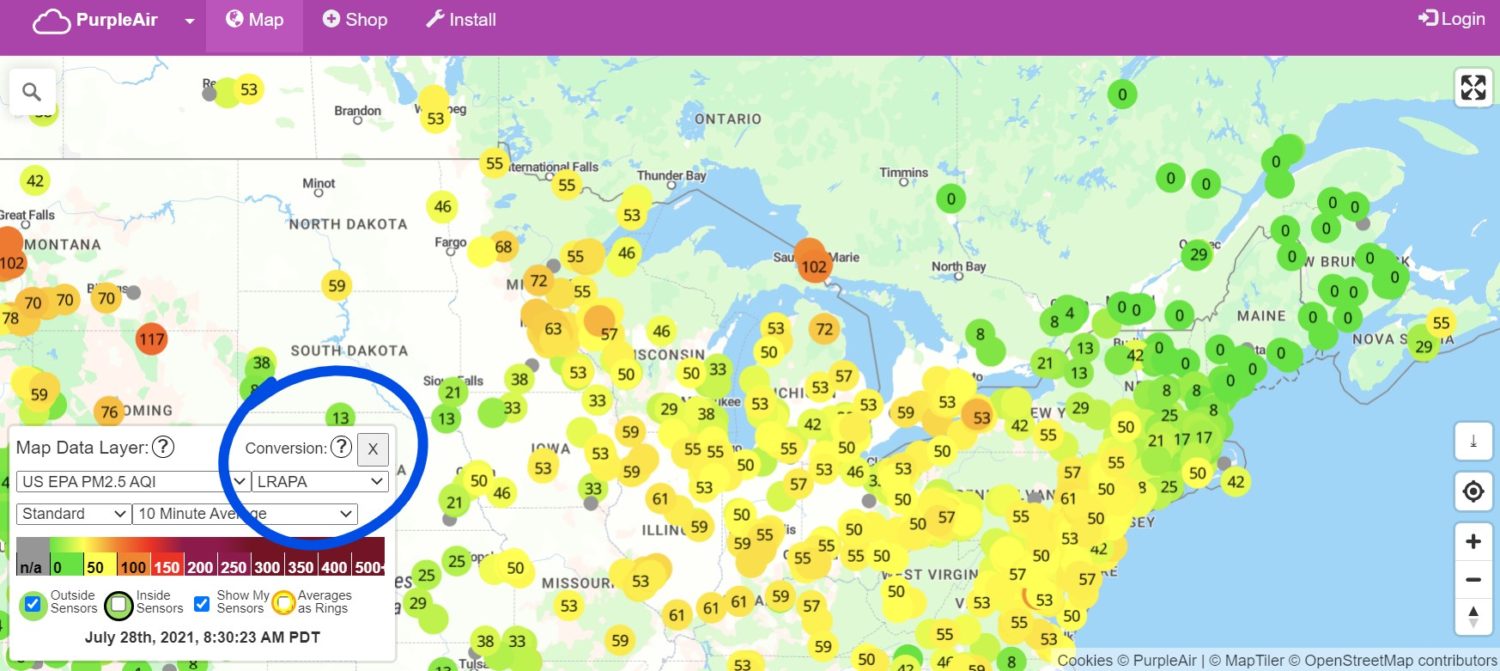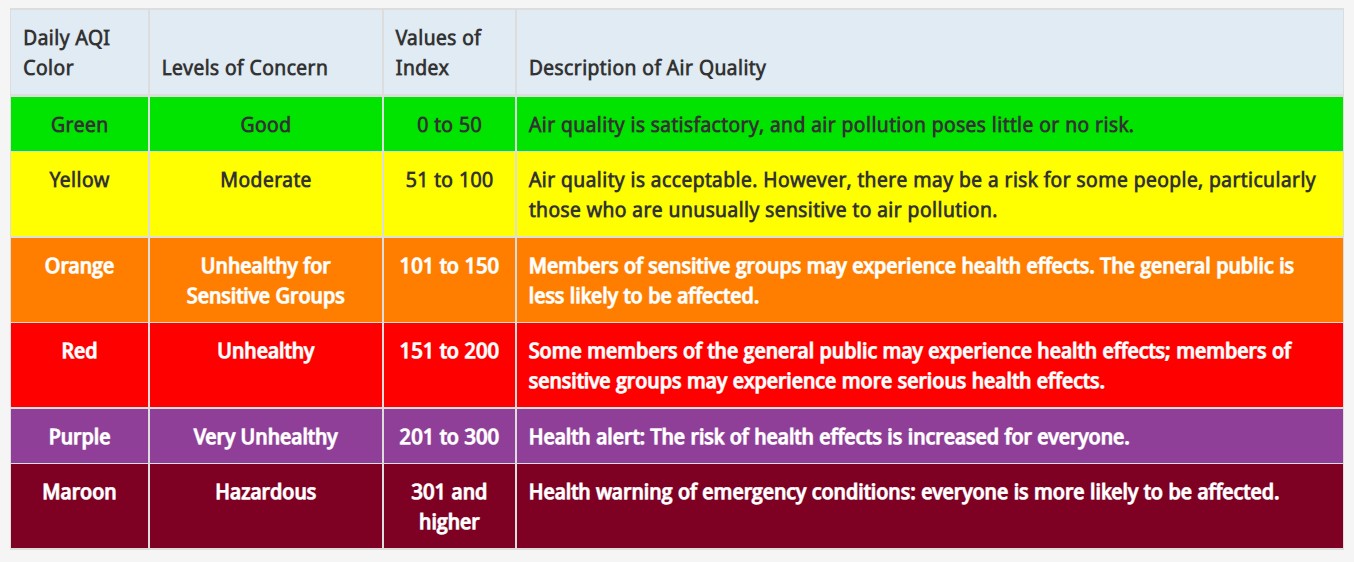This summer, smoke from wildfires burning in the western US and Canada has blown all the way to cities and states along the East Coast, causing air quality to deteriorate in cities throughout the Northeast and Midwest. Being subjected to smoke from wildfires has become disturbingly routine across the western United States, but recently the jet stream has been blowing the smoke from western wildfires thousands of miles across the country and exposing millions of people who don’t regularly experience smoke to hazardous conditions. With that in mind, here are the essential things to know so you can stay safe when skies are smoky.
1. Wildfire smoke is hazardous for your health
Wildfire smoke is a complex mixture of hundreds of pollutants, including gases such as carbon monoxide and formaldehyde as well as tiny particles small enough to be inhaled. This mixture derives from the burning of everything in the wildfire’s path, from plants to building materials.
Of particular concern when it comes to wildfire smoke is what’s known as PM2.5, which stands for particulate matter less than 2.5 microns in diameter—that’s about 30 times smaller in diameter than a human hair. When you breathe in these particles, they can cause a wide range of health problems. On days when wildfire smoke is present, emergency department visits for chronic conditions such as cardiovascular disease rise, as do visits for respiratory issues such as asthma. It’s important to note that even at relatively low levels, repeated PM2.5 exposure can cause negative health impacts or premature death, particularly if exposure is prolonged.

Children, pregnant people, and elderly adults are particularly sensitive to the negative health impacts of PM2.5 exposure. Children are generally more sensitive than adults because their lungs are still developing and, with each breath, they take in more air per pound of body weight relative to adults. Exposure to wildfire smoke during pregnancy has been associated with lower birth weights and higher rates of pre-term births. And elderly adults are at high risk because they have relatively high rates of cardiovascular and respiratory diseases.
During the 2020 wildfire season alone, researchers estimate that wildfire smoke resulted in between 1,200 and 3,000 additional deaths in California alone. And new research suggests that a wildfire smoke event in Nevada last year may have increased the number of COVID-19 cases in the area.
With all that in mind, it is critical to limit your exposure to wildfire smoke as much as possible.
2. How hazardous are smoke conditions where you live? Monitor your air quality
Sometimes the presence of wildfire smoke in your area will be obvious: when you step outside, it’ll smell like a campfire. Other times, you get all the harmful PM2.5 without the chemicals that contribute to the telltale smell, so it’s important to rely on data from air quality monitoring stations rather than on your eyes and nose alone.
There are two excellent tools for monitoring air quality, and they are increasingly linked to one another, which makes it easier to get a consistent picture of what’s going on.
AirNow is run by a group of local, state, tribal, and federal agencies and reports the Air Quality Index (AQI), an overall measure of air quality that includes measurements of PM2.5, ozone, and other pollutants. The data for the map come from very high-quality monitoring stations, but the station nearest to your location could be miles away because there aren’t that many of them.
PurpleAir also reports the AQI but the data come from lower-cost sensors that anyone can buy and install (indoor and outdoor sensors are indicated differently on the map). In San Francisco, where I live, there are dozens of PurpleAir sensors located just blocks away whereas there’s only one AirNow sensor in the city and it’s miles from my home. The rub is that the sensors are less accurate when it comes to measuring PM2.5 than the AirNow monitors.

To get the most accurate picture of what the air quality is like near you when smoke is present, I recommend using AirNow’s new Fire and Smoke map, which uses the AirNow network as well as corrected PurpleAir data so that you get the benefits of both networks. You can also apply a conversion within the PurpleAir map via a dropdown menu. Both the “US EPA” conversion and the “LRAPA” conversion will correct the data from the PurpleAir sensors so that it’s consistent with the more accurate measurements from AirNow sensors.
3. Know when to avoid outside activities
So what do you do with that air quality data once you have it in hand? AirNow groups AQI values into categories based on the level of concern pollution causes at a given time. At least one study has shown that when the AQI falls into the “unhealthy for sensitive groups” category or more severe categories, emergency room visits for smoke-related issues rise.

Source: AirNow; https://www.airnow.gov/aqi/aqi-basics
AirNow provides a helpful guide for how to change your activities based on the AQI category. Personally, when the AQI creeps up into the upper ranges of the “moderate” category, I keep my kids indoors since children are a sensitive group, and I don’t exercise outside. And with an AQI above 150—a level Boston and Philadelphia reached last week—air quality can have negative health effects even for those who aren’t in sensitive groups.
Because heat and wildfire smoke often coincide and both can strain health, exercise particular caution if a smoke event is coinciding with a heat wave.
4. Know which masks protect you from smoke
When the AQI reaches anything above moderate levels or if you have to be outside for long periods of time, a mask can help protect you from smoke, but not all masks are equally protective. The surgical masks and cloth masks we’ve all worn over the course of the COVID-19 pandemic are not effective at blocking PM2.5 from wildfire smoke. Same goes for construction masks, neck gaiters, scarves, etc. To protect yourself from wildfire smoke you’ll need an N95 mask. Luckily those are easier to get your hands on than they were a year ago, when the pandemic led to widespread N95 mask shortages. Many people find N95 respirator masks more comfortable to wear because they are more breathable. While those masks didn’t offer protection from the coronavirus because they allow the virus to be exhaled through the valve—and therefore transmitted to others—they’re fine for smoke provided that the valve is one-way (for exhalation) rather than two-way.

5. Filter your indoor air
Indoor air quality can be as much of an issue as outdoor air quality. If your home HVAC system has a HEPA filter, that’s great. If not, there are air purifiers with HEPA filters that effectively clean the air in a given room of your home. For larger rooms, I like the Coway Mighty. For smaller rooms, I like this Levoit purifier because it is fairly small and has a very quiet nighttime mode. I don’t have any scientific data on these, but our indoor air quality monitor registers a drop in indoor pollution when we run either of these.
6. Be prepared. With climate change, there could be more fires—and more smoke—on the way
According to the National Interagency Fire Center’s outlook for the 2021 wildfire season, the western US is expected to have an above-average risk of wildfires this August and September as a result of the ongoing drought and above-average temperatures the West is experiencing. In any given year, it’s impossible to know exactly where fires will break out and where the smoke from those fires will go, but given trends toward longer, more severe wildfire seasons, additional smoke events across the country wouldn’t be surprising in the years to come.

